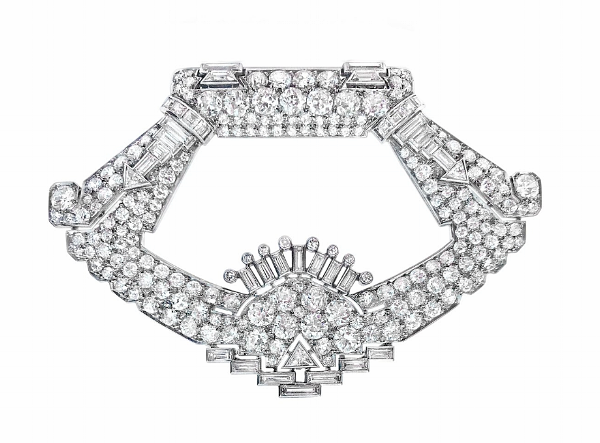Henri Picq - Platinum Maestro
During the first half of the 20th century, Cartier was renowned for offering the best-made pieces, owing to the master workshops and their skilled craftsmen on whom it regularly depended to execute its designs. Each atelier had its own speciality, such as Henri Lavabre for enamelling, Edmond Jaeger for watches and Maurice Couet for clocks. This network of ateliers in turn relied on each other, passing along pieces depending on whose particular skills were needed at each stage of the fabrication. After all, the union between design and realisation is no easy task; skilled labourers with the technical excellence must be engaged to bring the imagination to fruition.
The name of Henri Picq, then situated at the Rue du Quatre Septembre, is nowadays most closely associated with Cartier, for whom they made many pieces that went on to become emblems of the House’s golden epoch. Moreover, Picq even dedicated a team solely for the execution of Cartier designs, a collaboration that would go on to last for several decades. Hence, many iconic Cartier pieces of this period bear the poinçon of Henri Picq: the initials ‘H’ and ‘P’ flanking an ace of spades, ‘Picq’ being a homonym of ‘pique’, or spade.
An Art Deco ‘Tutti Frutti’ Bracelet, by Cartier with maker’s mark for Henri Picq, photo courtesy of Christie’s.
Evidence of Cartier’s high regard for the Picq workshop can be seen in many important commissions over time, notably the famous Exposition Internationale des Arts Décoratifs held in Paris in 1925. These grand World fairs were meant to exhibit the nation’s finest and France was determined to prove its unwavering supremacy in the arts. Being the eminent jeweller of the period, Cartier naturally participated, both as exhibitor and judge. The firm did not disappoint. Amongst all their remarkable and innovative items on show, a bracelet of undoubtable Mughal inspiration - with its carved rubies, emeralds and sapphires sprouting from a diamond ‘Tree of Life’ of life motif – stood out. This then, was the pinnacle of the ‘Tutti-Frutti’ style, the making of which was entrusted to none other than Henri Picq.
Despite this, Henri Picq was actually famed for something of quite a different kind – mastery of a rare and expensive metal which would eventually eclipse the time-hallowed gold and silver. Picq’s area of speciality, therefore, was the notoriously difficult to handle platinum.
Before the turn of the century, platinum’s use was limited to the industrial sciences. Although its discovery had occurred long beforehand, it’s melting point (700˚C higher than that of gold) prevented the obtention of a pure enough form for use in jewellery. But both new supply deposits and technology around 1900 changed everything, and due to its characteristics, platinum became THE metal of choice for mounting diamonds.
This revolutionised the way gems were set. For instance, due to its strength, a heavy mount was no longer necessary for support, lending a much lighter look to the overall setting. Also, the mount would be practically invisible, with the stones held together without any gaps. But perhaps what platinum is most known for, even now, is its whiteness. Resisting tarnish excellently without the need for plating (repeated or otherwise), its white, gleaming surface continuously reflects diamonds perfectly, even with the passage of time. In all of Paris, Cartier was reputed to use the finest platinum. This was by virtue of the especial whiteness of the particular platinum alloy unique to the Picq atelier and their exceptional technical skill at handling it.
A Belle-Époque diamond devant-de-corsage mounted in platinum, by Cartier, with maker’s mark for Henri Picq, photo courtesy of Christie’s.
Gem set and diamond brooch, by Henri Picq, photo courtesy of Sotheby’s.
An Art Deco diamond clip brooch, by Henri Picq, circa 1930s.
The design of the above clip brooch is distinctive as it encapsulates the elegant and ever-popular platinum and diamond style of the Art Deco period but it has already moved on from the strictly rectinileal planes of the 1920s and adapted to the softened angles of later times. In the same way, it corresponds to another concurrent trend: a play up of the volume, but without losing any of its inherent elegance. A three-dimensional work of architecture indeed.
Alongside the technical breakthrough in metallurgy leading to platinum’s supremacy, gem cutting innovations brought forth new cuts, heralding designs hitherto impossible to bring to life. In addition to the time-honoured brilliant cuts, the new contrasting baguettes, trapezoids and prisms etc. were used to achieve novel effects of light reflection. Designers were free to combine a seemingly infinite choice of cuts, depending on the pattern and harmony of scintillation sought.
Imaginative wearability is another quintessential feature of the clip brooches of the time. There were the classic placements of course, i.e. pinned over the bust, at the centre of a collar, as the clasp of a cape, or the ever-practical securing of the folds of a tunic etc., But women of the era found even more ingenious ways to embellish their ensemble, e.g. pinned to the shoulder straps, or perched right on top of the shoulder itself. Many would use them to adorn their hats, and even their hair. Some distinguished the simple cuffs of their sleeves by pinning large brooches to them. Although an already creative way was to pin them to the humble belt as a brooch-cum-buckle, even more original ones would employ them as shoe buckles! Who would be unable to love a jewel of so many uses? Even now, ideas have not been completely exhausted – huge antique stomachers could go very well pinned to the side of the waistband of a skirt or trousers whilst smaller pieces would just need a moiré or velvet ribbon to be worn as a choker. The possibilities are endless and this in itself adds value to the intrinsic beauty of these pieces. It is truly a marriage between practicality and elegance.
— Written by Esther Seah





